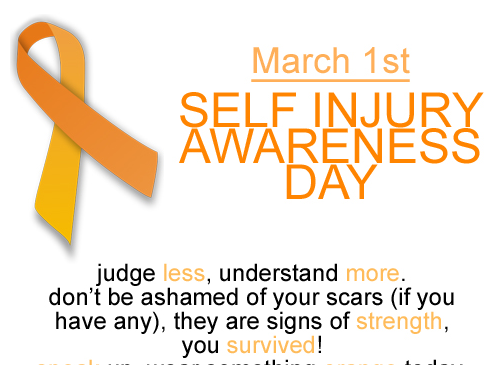Self-injury Awareness Day is on March 1 every year. This day is to raise awareness of the mental health problem of self-injury. People talk about why they choose to injure themselves in the hope they may prevent others from doing so. Organizations also run campaigns to raise awareness about self-injury to the medical community and to the general public. Around one per cent of us use self-injury to deal with difficulties in our lives. Despite this, it is a greatly misunderstood condition. Police and hospital staff often think self-injurers are suicidal and so do not give them the help they need. Some people wear orange awareness ribbons to show their support for awareness of this terrible problem.
自殘意識日會在每年的3月1日舉行。該節(jié)日的舉辦是為了提高人們對自殘所帶來的心理問題的重視。人們談論了選擇自殘的原因,并希望通過這種方式來避免其他人重蹈覆轍。許多組織還在醫(yī)療社區(qū)和公眾里面開展活動來提高人們對自殘的重視。有大約1%的人群會選擇自殘的方式來解決生活中的難題。盡管如此,自殘還是遭到了人們的誤解。警方和醫(yī)療工作者通常認為自殘是一種自殺,所以不要為他們提供他們所需要的幫助。許多人還佩戴橘紅色彩帶來向人們展示他們對自殘問題的支持。

Self-injury is the deliberate injury to your body without any intention to commit suicide. The illness is listed as a mental condition that is linked to personality disorders and depression. The most common way of self-injury is cutting the skin in places the injurer can easily hide. Many self-injurers prefer to conceal their injuries. Other methods include skin picking, hair pulling, alcohol abuse and forms of anorexia and bulimia. Many self-injurers say they get physical pleasure from their behaviour. The body releases natural drugs, endorphins, in response to physical injury. These give a person pleasant feelings and reduce anxiety and stress. Statistics show that four times more women than men do self-injury.
自殘是一種沒有自殺傾向,但是卻對身體造成故意傷害的行為。該疾病與人格障礙和抑郁癥有關。自殘最常見的方法是切割一些不容易被人們發(fā)現(xiàn)的皮膚。許多患者愿意去隱藏自己的受傷部位。其他方法還包括摳抓皮膚、拽頭發(fā)、酗酒以及各種癥狀的厭食癥和貪吃癥。許多自殘者稱他們感到身體上的快樂。由于這些行為,身體會釋放一種天然藥物,內(nèi)啡肽。這會讓他們感到快樂,并減輕焦慮和壓力。數(shù)據(jù)統(tǒng)計表明女性自殘的人數(shù)是男性的四倍。
譯文屬可可英語原創(chuàng),未經(jīng)允許,不得轉(zhuǎn)載。











